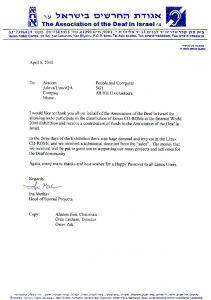Yesterday evening I experimented with two STT (speech to text) services – Live Transcribe and WebCaptioner.
I operated both of them in a meeting whose language was Hebrew. The meeting included a lecture in a hall and remote connection via Zoom. I elected to connect via Zoom.
Live Transcribe was operated on a tablet, which evasdropped on my laptop via speakers+microphone, and WebCaptioner was operated on a browser running on my laptop. Zoom ran on my laptop as an application. Both STT services were setup to recognize Hebrew speech.
My finding was that most of the time, the services did not deliver the goods. They emitted Hebrew words without grammar and out of the meeting’s context. However, there were moments in which they worked correctly.
I also noticed that when the services did not work correctly, each of them had different output. When they worked correctly, the texts they produced were similar to each other.
During the meeting, the lecturers did not use a wireless microphone located near their mouths. They stood at different distances from the microphone. When they stood near the microphone, the services worked better than when the lecturers stood far away from the microphone.
In “worked better”, I mean that the services continuously emitted text, rather than long periods of no activity with interspersed short text segments.
The above confirms what I found long time ago – STT services need to receive the same treatment as the HOH (hard of hearing people). Just as environmental noises interfere with HOH ability to understand speech, they interfere also with STT services.
המרת דיבור לטקסט בעברית
אתמול בערב עשיתי ניסוי ב-Live Transcribe וב-WebCaptioner.
הפעלתי את שתיהן במפגש שהתקיים בעברית. המפגש כלל הרצאה באולם + אפשרות להתחבר דרך זום. בחרתי להתחבר דרך זום.
ה-Live Transcribe הופעל על טאבלט שצותת ללאפטופ באמצעות רמקולים+מיקרופון, ואילו WebCaptioner הופעל בדפדפן על אותו הלאפטופ שעליו זום רץ כאפליקציה. שתי התוכנות כוונו לזהות דיבור בעברית.
הממצא שלי היה שרוב הזמן שתי התוכנות לא סיפקו את הסחורה. הן פלטו מילים עבריות ללא תחביר וללא קשר עם נושא המפגש. עם זאת היו רגעים שבהם הן עבדו נכון.
שמתי לב גם שכשהתוכנות לא עובדות נכון, כל אחת מוציאה פלט אחר. כשהן עובדות נכון, הטקסטים שהן מוציאות דומים זה לזה.
במפגש, המרצים לא השתמשו במיקרופון אלחוטי שנמצא קרוב מאוד לפה שלהם, אלא היו עומדים במרחקים משתנים מהמיקרופון. כשעמדו קרוב למיקרופון, התוצאות היו יותר טובות מאשר כשהם עמדו רחוק ממנו.
ב-“יותר טובות” אני מתכוון לכך שהתוכנות פלטו כל הזמן טקסט, במקום שתיקות ארוכות עם קטעי טקסט קצרים מפעם לפעם.
זה מאשר את הממצא שעליתי עליו לפני הרבה זמן – צריך להתייחס לתוכנות לזיהוי דיבור ממוחשב כמו אל כבדי שמיעה. כמו שרעשי סביבה מפריעים להם מאוד להבין דיבור, גם לתוכנות רעשי סביבה מפריעים מאוד.

